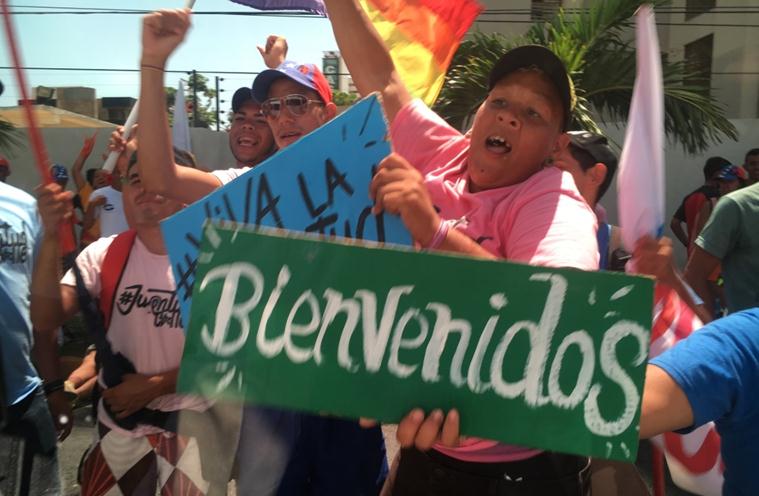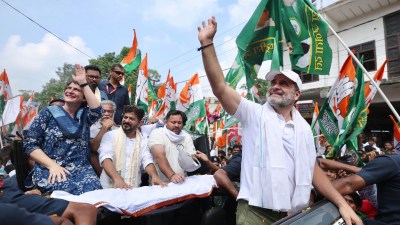The Night is Long in Margarita
The Venezuelan island not only lent its name to the popular cocktail, but it was also a place where the party never stopped. Hit by an economic crisis, food shortage and a rise in crime, the island is now a shadow of its past.
 The beach of Isla Margarita
The beach of Isla Margarita
As the Air India One approaches the Santiago Mariño Caribbean Interna-tional Airport, a patch of golden brown, and, then, a mass of green shows up on a deep blue canvas. Isla Margarita in Venezuela, which hosted the 17th Non-Aligned Movement summit, stands out with its mountains and beaches, and giant saguaros scattered on the Caribbean shores.
On the road to the hotel in Porlamar, Margarita island’s largest commercial district, billboards proclaim a high human development index, a low poverty rate, and praises its president, Nicolas Maduro. Every few kilometres along the mountainous landscape, however, armed military men stand guard. A helicopter hovers overhead.
Contrary to what you read about vivacious Porlamar, its shops have downed shutters. The town looks like it is under curfew. Porlamar is home to a third of Margarita’s population (at about 1,00,000). As a tax-free port, it has all the shopping avenues, the largest being the Boulevard Guevara. Margarita, which has lent its name to the popular tequila-based cocktail, was famous for its nightlife, pearls and handicrafts. Stores used to be open till 11 pm, locals will tell you. But after the economic crisis set in after 2012, leading to food shortage and a rise in crime, the island has become a shadow of its past.
Historically, Porlamar traded salt for weapons to guard its frontiers, our tour guide Natalie Gonzalez tells us, pointing at salt pans on the shore from the top of the lighthouse Faro Punta Ballena in Pampatar area. Discovered by Christopher Columbus, Margarita’s white-and-grey sand beaches that fringe the blue-and-green Caribbean sea, are now barren. Only on Sunday afternoons do you find families swimming, sunbathing or building sand castles on beaches like Playa el agua. After a long afternoon of bathing, playing picnicking and having the local beer, people leave the beaches before sundown for fear of being mugged.
The NAM summit had to be held in Isla Margarita and not the capital, Caracas, because the crime rate there is much higher. “While security on an island could be controlled, it could not be done so on mainland,” says Samantha Leon, who runs a travel company. Maduro’s government is said to have flown in 14,000 army and police personnel to guard the island and closed it down completely. An advisory in one of Porlamar’s popular beachside hotels says, “Do not display large amounts of cash, or valuables such as jewellery, watches, cameras or video cameras… Beam tranquility, confidence and assurance … If confronted, surrender your valuables. Your money and material objects can be replaced, you cannot be.”
 Scene outside the NAM summit venue
Scene outside the NAM summit venue
Sometime after midday, mediapersons are evacuated from the media centre. A German Shepherd stands outside, waiting for orders. Its ribcage is visible under its sparse brown coat. Earlier this month, reports went viral of Venezuelans abandoning pets, as there was not enough food even for themselves. Many rooms in the hotel are occupied by police and military personnel, who are here to secure the delegates here.
If travel websites told you Margarita was a place to party, and that Venezuelans loved the American dollar, they are wrong or dated. Most hotels, shops and supermarkets accept only Bolivars. The local money-changer runs out of a bag full of Bolivars after changing a handful of dollars. In the parallel market, a 1,000 Bolivars is worth one US dollar. In a superstore in La Asuncion, the capital of Nueva Esparta of which Isla Margarita is a part, bare shelves stare at customers. People stand in queues at counters and check out with barely a litre of milk, cornflakes and cacao.
There are exceptions, like Nelly, who runs a souvenir shop here, and happily accepts dollars. As our group crowded her store, she called in help — to convert , calculate and hand back change. She chats about her father who migrated from India to Trinidad and Tobago, and then to Margarita. “His name was Rampasand,” she says in a heavy Spanish accent.
Arvind Upadhyay, who is employed with an Ahmedabad-based pharmaceutical company, came here in 2012 and saw happier times. “We used to roam at nights, the streets were lively and stores open till late,” he recalls. As the price of crude kept dropping since 2014, everything went southward.
The local transport closes at 3 pm because “they do not have spares to run the service,” says Leon. Cabs cost three times more after “happy hour”. All shops close by 4.30 pm. Beaches by 6 pm.
With the food shortage, people get rations by turn. “It is usually decided by the serial number on the cedula identidad, a national identity document. If you are lucky, your number is on the list within a month,” says Upadhyay. His company supplies intravenal drugs, but business has been bad. “Medicines are not available, and doctors have started to leave the country,” he says.
Barely two weeks before the summit began on September 17, President Maduro had been chased out of Villa Rosa, a village here, by people clanking pots and pans. Maduro has been facing noisy protests demanding a referendum on him. All business establishments around the NAM summit venue are shut. “They don’t want guests interacting with locals, and letting stories of the crisis out,” says an Indian official posted here.
Leon, mother to a 15-year-old boy and a 10-year-old girl, takes the 30-minute flight to Caracas to get supplies to run her home. The island had run out of milk, bread, rice and sugar till a month before the summit. “There is never enough food,” she says, adding that Isla Margarita has better food supplies only because the government flew in everything for the summit. You do spot street stalls selling fresh fruits — Venezuela abounds in bananas, papaya, star fruit and mangoes, besides fish and molluscs. The staple food here is fried ripe bananas and arepa, a corn patty.
 Queues at the supermarket checkout counter in La Asuncion; empty shelves in the same supermarket.
Queues at the supermarket checkout counter in La Asuncion; empty shelves in the same supermarket.
As you drive past the town, a crowd builds up at the summit venue. Young boys and girls hold up the national flag and banners saying, “Bienvenidos (welcome)” and “Vive la Juventud (Long live the youth)”. At the summit venue, a window displays a tetrapack of milk in a fancy wicker basket, a stack of Nutella jars, cookies and so forth — things that are out of reach of the common Margaritan (A BBC news report had said a jar of Nutella was being sold for 15,000 Bolivars).
On the way back to the airport, a billboard proclaims, “Primero los derechos del pueblo” (First, the people’s rights). Ironical, for a country where everything seemed to be going wrong for its people. Gasoline cost 60 paise a litre and a peg of the famous Cacique rum costs 2,300 Bolivars (about Rs 13,000).
Back at the Delhi airport, the woman security officer’s eyes light up during the baggage screening: “Aap Venezuela gayi thi? Woh desh jahan beauty queens hotey hain? (You went to Venezuela? The country where they have beauty queens?)”



- 01
- 02
- 03
- 04
- 05
























